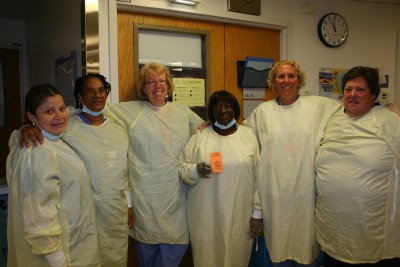6B Spreads Hand Hygiene Success

Modeling the new yellow precaution gowns are, from left, Maria Zelaya, Nicole Joseph, Nancy Mahan, Una Yearwood, Rebecca Spitz and Carolyn Clark.
Rebecca Spitz, RN, nurse in-charge, spurred a three-month interdisciplinary hand hygiene initiative earlier this year when she became alarmed over reports of MRSA and VRE in the news. “Patients hear about these infections, and they get scared they’re going to get them,” said Spitz, who has worked on 6B for 15 years. “We have to do everything possible to help prevent them.”
The efforts that 6B’s frontline staff put forth ultimately resulted in a 15 percent increase in hand hygiene compliance and a culture change on the pod. This fall, the changes will be rolled out across the other Hematology/Oncology units.
Many of the changes to improve hand hygiene compliance were simple, as an interdisciplinary group of nurses, patient care assistants, physicians, physician assistants, unit coordinators, and staff from environmental services, materials management, food services and other areas learned by coming together to discuss challenges.
“We did a tour of the unit and realized that the boxes of gloves were stacked in front of the Purell outside some of the patient rooms,” said Colleen Zidik, BSN, MBA, RN, Quality program manager, who brought the group together. “Nicole Joseph and Una Yearwood, the day PCAs on our team, made reminder notes asking all PCAs to stack the boxes only two high to keep the pumps visible. That small change made a big difference.”
Another concern was not being able to find a laundry basket for linens immediately after stepping out of a precaution room in a gown. “We trialed new hampers to put just inside each patient room,” said Zidik. “That way, the gown can be taken off right there, preventing germs from spreading.”
Other changes included installing Asepti-wipe containers in patient rooms to facilitate cleaning of equipment; purchasing new precaution gowns that are impervious on the front, as opposed to cotton; and working with Food Services to install a holder for food trays coming out of patient rooms.
Daily huddles with an action team leader and frontline staff on the pod provided time for the team to check in and tweak the changes that weren’t working. “The culture of the unit has really changed because of this initiative,” said Carolyn Clark, unit coordinator.
One reason for 6B’s success is that frontline staff suggested the improvements and saw almost immediate implementation. “When ideas were brought forward, changes actually got made,” remarked Nancy Mahan, RN.
That’s thanks mainly to Jeanne Barton, Support Services operations director. She took the ideas and went to various support services departments to help implement them—sometimes as fast as 48 hours later.